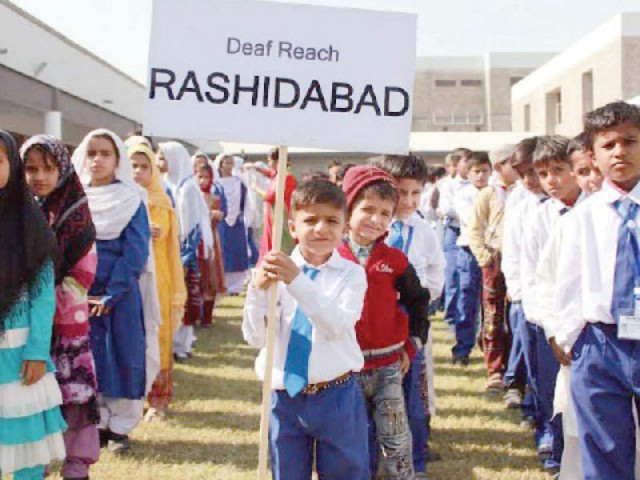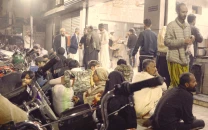Book designed to increase vocabulary of hearing-impaired kids
The book, which comprises over 1,000 words, is available online for free

Morning assembly at the Deaf School Rashidabad branch. Over 1,000 aurally challenged children now have access to seven different branches of Deaf Reach Schools across the country. PHOTO: FILE
A five-year-old deaf child has a minimum vocabulary of 50 words as compared to a normal kid of the same age who may know 1,000 words. "Why can't it be the same for the deaf child?" questioned the executive director of the Family Education Services Foundation (FESF), Richard Geary and board of member of Deaf Reach Schools.
Often, the ability to hear and to speak via the same mode is a blessing that comes naturally. The Deaf Reach School, a project of FESF is trying to provide the same opportunity for deaf children by giving them a language to communicate in.
A lexicon of 5,000 words has been developed by the Deaf Reach School and Pakistan Sign Languages. Of these 1,000 basic signs have been compiled in book form, which is also available online for free access.
The book offers
The 1,000 Basic Signs Book can serve as a language guide to communicate with aurally-impaired people. In addition, it can be a useful tool in classroom teaching as it can bridge the gap between teacher and pupil. According to Geary, the FESF has documented the existing sign language used in Pakistan while the basic alphabets and numbers remain the same globally. "Every country has its own indigenous language. The sign language too varies from one place to another," he said.
Read: Hearing impaired students present chilling version of national anthem in sign language

The book, besides being facilitative both in Urdu and English, has the whole of Pakistan covered. It accommodates signs in four regional languages of Pakistan, Punjabi, Sindhi, Balochi and Pashto. Comprising basic words for colours such as 'orange', terminologies like 'democracy' and differential words like 'approve' and 'agree', the word collection is expansive and has the potential to offer a solid foundation to learners.
Origins of the book
The process of assigning a particular sign to a word is not as complicated as it appears on the face of it. It is very fascinating to know how culture, traditional practices and ghettos inspire languages as they have for the hearing-impaired. For instance, to say the word 'mother' the hands are gestured towards the nose pin (a strong indication in our culture as nose pins are often associated with mothers). Similarly for father it's a motion of fist towards the chin to show beard while for a brother it's a moustache.
Read: Deaf Reach School opens doors for the under-privileged in Rashidabad
"It was actually a fun process as the signs for deaf are actually what we see," said Margarete Isaac, a mathematics teacher who has been teaching at the Deaf Reach School for the last nine years. "The colour yellow is a simple rub on the cheek to indicate ubtan in mayoun," she told Express Tribune.
School activities
Over 1,000 aurally challenged children now have access to seven different branches of Deaf Reach Schools across the country. Apart from basic schooling that goes up to matriculation, the school also provides vocational and skills training so that these individuals can be productive members of the society.
The system of teaching at Deaf Reach School is such that a hearing and deaf teacher work together in classroom. According to Geary, as much as 55 per cent of their staff is aurally impaired.
Rukhsana and Sobia manage the arts and embroidery classes. Girls as young as 12 years paint huge canvases suggestive of artistic clarity and thought. Sobia comes up with different techniques in her art work while Rukhsana communicates it all to the young minds through sign language.
Published in The Express Tribune, August 26th, 2015.



















COMMENTS
Comments are moderated and generally will be posted if they are on-topic and not abusive.
For more information, please see our Comments FAQ